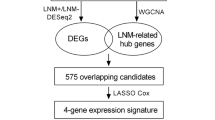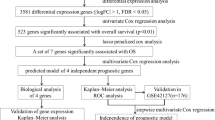Abstract
Purpose
Intra-tumor heterogeneity and high mortality among patients with non-small-cell lung carcinoma (NSCLC) emphasize the need to identify reliable prognostic markers unique to each subtype.
Methods
In this study, univariate cox regression and prognostic index (PI)-based approaches were used to develop models for predicting NSCLC patients’ subtype-specific survival.
Results
Prognostic analysis of TCGA dataset identified 1334 and 2129 survival-specific genes for LUSC (488 samples) and LUAD (497 samples), respectively. Individually, 32 and 271 prognostic genes were found and validated in GSE study exclusively for LUSC and LUAD. Nearly, 9–10% of the validated genes in each subtype were already reported in multiple studies thus highlighting their importance as prognostic biomarkers. Strong literature evidence against these prognostic genes like “ELANE” (LUSC) and “AHSG” (LUAD) instigates further investigation for their therapeutic and diagnostic roles in the corresponding cohorts. Prognostic models built on five and four genes were validated for LUSC [HR = 2.10, p value = 1.86 × 10−5] and LUAD [HR = 2.70, p value = 3.31 × 10−7], respectively. The model based on the combination of age and tumor stage performed well in both NSCLC subtypes, suggesting that despite having distinctive histological features and treatment paradigms, some clinical features can be good prognostic predictors in both.
Conclusion
This study advocates that investigating the survival-specific biomarkers restricted to respective cohorts can advance subtype-specific prognosis, diagnosis, and treatment for NSCLC patients. Prognostic models and markers described for each subtype may provide insight into the heterogeneity of disease etiology and help in the development of new therapeutic approaches for the treatment of NSCLC patients.



Similar content being viewed by others
Data availability
The data that support the findings of this study are openly available on TCGA website as well as in the supplementary files.
References
Cancer Genome Atlas Research Network (2014) Comprehensive molecular profiling of lung adenocarcinoma. Nature 511(7511):543–550. https://doi.org/10.1038/nature13385
Chang JT-H, Lee YM, Huang RS (2015) The impact of the Cancer Genome Atlas on lung cancer. Transl Res J Lab Clin Med 166(6):568–585. https://doi.org/10.1016/j.trsl.2015.08.001
Chaudhary K, Poirion OB, Lu L, Garmire LX (2018) Deep learning-based multi-omics integration robustly predicts survival in liver cancer. Clin Cancer Res Off J Am Assoc Cancer Res 24(6):1248–1259. https://doi.org/10.1158/1078-0432.CCR-17-0853
Chen J, Sam L, Huang Y, Lee Y, Li J, Liu Y, Xing HR, Lussier YA (2010) Protein interaction network underpins concordant prognosis among heterogeneous breast cancer signatures. J Biomed Inform 43(3):385–396. https://doi.org/10.1016/j.jbi.2010.03.009
Cheng YQB, Shao N, Jia Y, Song Q, Tan B, Wang J (2020) Prognostic value of immune-related genes in the tumor microenvironment of lung adenocarcinoma and lung squamous cell carcinoma. Aging 12(6):4757–4777. https://doi.org/10.18632/aging.102871
Deng F, Chen D, Wei X, Lu S, Luo X, He J, Liu J, Meng T, Yang A, Chen H (2020) Development and validation of a prognostic classifier based on HIF-1 signaling for hepatocellular carcinoma. Aging 12(4):3431–3450. https://doi.org/10.18632/aging.102820
Dyrskjøt L, Reinert T, Algaba F, Christensen E, Nieboer D, Hermann GG, Mogensen K, Beukers W, Marquez M, Segersten U, Høyer S, Ulhøi BP, Hartmann A, Stöhr R, Wach S, Nawroth R, Schwamborn K, Tulic C, Simic T et al (2017) Prognostic Impact of a 12-gene progression score in non-muscle-invasive bladder cancer: a prospective multicentre validation study. Eur Urol 72(3):461–469. https://doi.org/10.1016/j.eururo.2017.05.040
Frost HR, Amos CI (2018) A multi-omics approach for identifying important pathways and genes in human cancer. BMC Bioinform 19(1):479. https://doi.org/10.1186/s12859-018-2476-8
He X, Xu H, Zhao W, Zhan M, Li Y, Liu H, Tan L, Lu L (2019) POPDC3 is a potential biomarker for prognosis and radioresistance in patients with head and neck squamous cell carcinoma. Oncol Lett 18(5):5468–5480. https://doi.org/10.3892/ol.2019.10888
Kumar R, Patiyal S, Kumar V, Nagpal G, Raghava GPS (2019) In silico analysis of gene expression change associated with copy number of enhancers in pancreatic adenocarcinoma. Int J Mol Sci. https://doi.org/10.3390/ijms20143582
Lathwal A, Arora C, Raghava GPS (2019) Prediction of risk scores for colorectal cancer patients from the concentration of proteins involved in mitochondrial apoptotic pathway. PLoS ONE 14(9):e0217527. https://doi.org/10.1371/journal.pone.0217527
Li B, Feng W, Luo O, Xu T, Cao Y, Wu H, Yu D, Ding Y (2017) Development and validation of a three-gene prognostic signature for patients with hepatocellular carcinoma. Sci Rep. https://doi.org/10.1038/s41598-017-04811-5
Li P, Ren H, Zhang Y, Zhou Z (2018) Fifteen-gene expression based model predicts the survival of clear cell renal cell carcinoma. Medicine (United States) 97(33):e11839. https://doi.org/10.1097/MD.0000000000011839
Liu Y, Wu L, Ao H, Zhao M, Leng X, Liu M, Ma J, Zhu J (2019a) Prognostic implications of autophagy-associated gene signatures in non-small cell lung cancer. Aging Impact J LLC 11(23):11440–11462. https://doi.org/10.18632/aging.102544
Liu Y, Yang N, Peng X, Liu G, Zhong H, Liu L (2019b) One-lincRNA and five-mRNA based signature for prognosis of multiple myeloma patients undergoing proteasome inhibitors therapy. Biomed Pharmacother Biomed Pharmacother 118:109254. https://doi.org/10.1016/j.biopha.2019.109254
Lv Z, Lei T (2020) Systematical identifications of prognostic meaningful lung adenocarcinoma subtypes and the underlying mutational and expressional characters. BMC Cancer. https://doi.org/10.1186/s12885-019-6462-y
Ma B, Geng Y, Meng F, Yan G, Song F (2020a) Identification of a sixteen-gene prognostic biomarker for lung adenocarcinoma using a machine learning method. J Cancer 11(5):1288–1298. https://doi.org/10.7150/jca.34585
Ma X, Ren H, Peng R, Li Y, Ming L (2020b) Identification of key genes associated with progression and prognosis for lung squamous cell carcinoma. PeerJ 8:e9086. https://doi.org/10.7717/peerj.9086
Mandelboum S, Manber Z, Elroy-Stein O, Elkon R (2019) Recurrent functional misinterpretation of RNA-seq data caused by sample-specific gene length bias. PLoS Biol 17(11):e3000481. https://doi.org/10.1371/journal.pbio.3000481
Matsuda A, Yamaoka K, Tango T (2012) Quality of life in advanced non-small cell lung cancer patients receiving palliative chemotherapy: a meta-analysis of randomized controlled trials. Exp Ther Med 3(1):134–140. https://doi.org/10.3892/etm.2011.368
Meng F, Zhang L, Ren Y, Ma Q (2019) The genomic alterations of lung adenocarcinoma and lung squamous cell carcinoma can explain the differences of their overall survival rates. J Cell Physiol 234(7):10918–10925. https://doi.org/10.1002/jcp.27917
Midthun DE (2011) Screening for lung cancer. Clin Chest Med 32(4):659–668. https://doi.org/10.1016/j.ccm.2011.08.014
Molina JR, Yang P, Cassivi SD, Schild SE, Adjei AA (2008) Non-small cell lung cancer: epidemiology, risk factors, treatment, and survivorship. Mayo Clin Proc 83(5):584–594. https://doi.org/10.4065/83.5.584
Piñero J, Ramírez-Anguita JM, Saüch-Pitarch J, Ronzano F, Centeno E, Sanz F, Furlong LI (2020) The DisGeNET knowledge platform for disease genomics: 2019 update. Nucleic Acids Res 48(D1):D845–D855. https://doi.org/10.1093/nar/gkz1021
Rekhtman N, Paik PK, Arcila ME, Tafe LJ, Oxnard GR, Moreira AL, Travis WD, Zakowski MF, Kris MG, Ladanyi M (2012) Clarifying the spectrum of driver oncogene mutations in biomarker-verified squamous carcinoma of lung: lack of EGFR/KRAS and presence of PIK3CA/AKT1 mutations. Clin Cancer Res Off J Am Assoc Cancer Res 18(4):1167–1176. https://doi.org/10.1158/1078-0432.CCR-11-2109
Relli V, Trerotola M, Guerra E, Alberti S (2018) Distinct lung cancer subtypes associate to distinct drivers of tumor progression. Oncotarget 9(85):35528–35540. https://doi.org/10.18632/oncotarget.26217
Sanchez-Vega F, Mina M, Armenia J, Chatila WK, Luna A, La KC, Dimitriadoy S, Liu DL, Kantheti HS, Saghafinia S, Chakravarty D, Daian F, Gao Q, Bailey MH, Liang WW, Foltz SM, Shmulevich I, Ding L, Heins Z et al (2018) Oncogenic signaling pathways in the cancer genome atlas. Cell 173(2):321–337.e10. https://doi.org/10.1016/j.cell.2018.03.035
Sandler A, Gray R, Perry MC, Brahmer J, Schiller JH, Dowlati A, Lilenbaum R, Johnson DH (2006) Avastin in metastatic NSCLC- Sandler data (Paclitaxel-carboplatin alone or with bevacizumab for non-small-cell lung cancer. N Engl J Med 355(24):2542–2550. https://doi.org/10.1056/NEJMoa061884
Sheng M, Xie X, Wang J, Gu W (2019) A pathway-based strategy to identify biomarkers for lung cancer diagnosis and prognosis. Evolut Bioinf Online 15:1176934319838494. https://doi.org/10.1177/1176934319838494
Shi M, Xu G (2019) Development and validation of GMI signature based random survival forest prognosis model to predict clinical outcome in acute myeloid leukemia. BMC Med Genom. https://doi.org/10.1186/s12920-019-0540-5
Siegel RL, Miller KD, Jemal A (2018) Cancer statistics, 2018. CA Cancer J Clin 68(1):7–30. https://doi.org/10.3322/caac.21442
Song YJ, Tan J, Gao XH, Wang LX (2018) Integrated analysis reveals key genes with prognostic value in lung adenocarcinoma. Cancer Manag Res 10:6097–6108. https://doi.org/10.2147/CMAR.S168636
Stewart DJ, Tomiak E, Shamji FM, Maziak DE, MacLeod P (2004) Phase II study of alternating chemotherapy regimens for advanced non-small cell lung cancer. Lung Cancer (Amsterdam, Netherlands) 44(2):241–249. https://doi.org/10.1016/j.lungcan.2003.10.009
TCGA (2012) Comprehensive genomic characterization of squamous cell lung cancers: pathways and integrated analysis (Supplementary material). Nature 489(7417):519–525. https://doi.org/10.1038/nature11404
Tseng GC, Ghosh D, Feingold E (2012) Comprehensive literature review and statistical considerations for microarray meta-analysis. Nucleic Acids Res 40(9):3785–3799. https://doi.org/10.1093/nar/gkr1265
Wang Y, Ren F, Chen P, Liu S, Song Z, Ma X (2018) Identification of a six-gene signature with prognostic value for patients with endometrial carcinoma. Cancer Med 7(11):5632–5642. https://doi.org/10.1002/cam4.1806
Yan J, Kim Y-S, Yang X-P, Li L-P, Liao G, Xia F, Jetten AM (2007) The ubiquitin-interacting motif containing protein RAP80 interacts with BRCA1 and functions in DNA damage repair response. Can Res 67(14):6647–6656. https://doi.org/10.1158/0008-5472.CAN-07-0924
Yang S, Chen L, Chan DW, Li QK, Zhang H (2017) Protein signatures of molecular pathways in non-small cell lung carcinoma (NSCLC): comparison of glycoproteomics and global proteomics. Clin Proteom. https://doi.org/10.1186/s12014-017-9166-9
Yuan Y, Van Allen EM, Omberg L, Wagle N, Amin-Mansour A, Sokolov A, Byers LA, Xu Y, Hess KR, Diao L, Han L, Huang X, Lawrence MS, Weinstein JN, Stuart JM, Mills GB, Garraway LA, Margolin AA, Getz G, Liang H (2014) Assessing the clinical utility of cancer genomic and proteomic data across tumor types. Nat Biotechnol 32(7):644–652. https://doi.org/10.1038/nbt.2940
Zhang J, Xu M, Gao H, Guo J-C, Guo Y-L, Zou M, Wu X-F (2018) Two protein-coding genes act as a novel clinical signature to predict prognosis in patients with ovarian serous cystadenocarcinoma. Oncol Lett 15(3):3669–3675. https://doi.org/10.3892/ol.2018.7778
Zhao Q, Shi X, Xie Y, Huang J, Shia B, Ma S (2015) Combining multidimensional genomic measurements for predicting cancer prognosis: observations from TCGA. Brief Bioinform 16(2):291–303. https://doi.org/10.1093/bib/bbu003
Zhu Y, Qiu P, Ji Y (2014) TCGA-assembler: open-source software for retrieving and processing TCGA data. Nat Methods 11(6):599–600. https://doi.org/10.1038/nmeth.2956
Funding
There is no funding available for this paper.
Author information
Authors and Affiliations
Contributions
Conceptualization, AL, RK, and GPSR; methodology, AL, RK, and GPSR; formal analysis, AL, RK, and GPSR.; investigation, AL, RK, and GPSR; code development, AL; visualization and figures, AL, RK, and GPSR; interpretation of data and results, AL, RK, CA and GPSR; supervision, GPSR; project administration, GPSR; funding acquisition, GPSR; writing and editing, AL, RK, CA, and GPSR. All authors have read and agreed to the published version of the manuscript.
Corresponding author
Ethics declarations
Conflict of interest
The authors declare no conflict of interest.
Additional information
Publisher's Note
Springer Nature remains neutral with regard to jurisdictional claims in published maps and institutional affiliations.
Electronic supplementary material
Below is the link to the electronic supplementary material.
Rights and permissions
About this article
Cite this article
Lathwal, A., Kumar, R., Arora, C. et al. Identification of prognostic biomarkers for major subtypes of non-small-cell lung cancer using genomic and clinical data. J Cancer Res Clin Oncol 146, 2743–2752 (2020). https://doi.org/10.1007/s00432-020-03318-3
Received:
Accepted:
Published:
Issue Date:
DOI: https://doi.org/10.1007/s00432-020-03318-3




